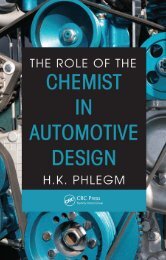Lightweight Electric/Hybrid Vehicle Design
Lightweight Electric/Hybrid Vehicle Design
Lightweight Electric/Hybrid Vehicle Design
Create successful ePaper yourself
Turn your PDF publications into a flip-book with our unique Google optimized e-Paper software.
Introduction xiii<br />
reached the customer, which may have led engineers to be less conscious of the weight/performance<br />
trade-off in detail design. Individual parts could well be specified on the basis of subjective<br />
judgement, without the sobering discipline of the above trade-off analysis.<br />
Not so, of course, for the early aeronautical design engineers whose prototypes either ‘flew or<br />
fell out of the sky’. Aircraft structural designers effectively pioneered techniques of thin-walled<br />
structural analysis to try to predict as far as possible the structural performance of parts ‘before<br />
they left the drawing board’, and in so doing usually economized on any surplus mass. These<br />
structural analysis techniques gave early warning of buckling collapse and provided a means of<br />
idealization that allowed load paths to be traced. In the dramatic weight reduction programmes<br />
called for by the ‘supercar’ design requirements, to be discussed in Chapters 4 and 6, these attitudes<br />
to design could again have great value.<br />
<strong>Design</strong> calculations, using techniques for tracing loads and determining deflections and stresses<br />
in structures, many of which derive from pioneering aeronautical structural techniques, are also<br />
recommended for giving design engineers a ‘feel’ for the structures at the concept stage. The<br />
design engineer can thus make crucial styling and packaging decisions without the risk of weakening<br />
the structure or causing undue weight gain. While familiar to civil and aeronautical engineering<br />
graduates these ‘theory of structures’ techniques are usually absent from courses in mechanical<br />
and electrical engineering, which may be confined to the ‘mechanics of solids’ in their structures<br />
teaching. For students undertaking design courses, or projects, within their engineering degree<br />
studies, these days the norm rather than the exception, the timing of the book’s publication is<br />
within the useful period of intense decision making throughout the EV industry. It is thus valuable<br />
in focusing on the very broad range of other factors–economic, ergonomic, aesthetic and even<br />
political–which have to be examined alongside the engineering science ones, during the conceptual<br />
period of engineering design.<br />
0.2.1 FARTHER-REACHING FACTORS OF ‘TOTAL DESIGN’<br />
Since the electric vehicle has thus far, in marketing terms, been ‘driven’ by the state rather than<br />
the motoring public it behoves the stylist and product planner to shift the emphasis towards the<br />
consumer and show the potential owner the appeal of the vehicle. Some vehicle owners are also<br />
environmentalists, not because the two go together, but because car ownership is so wide that the<br />
non-driving ‘idealist’ is a rarity. The vast majority of people voting for local and national<br />
governments to enact antipollution regulation are vehicle owners and those who suffer urban<br />
traffic jams, either as pedestrians or motorists, and are swinging towards increased pollution control.<br />
The only publicized group who are against pollution control seem to be those industrialists who<br />
have tried to thwart the enactment of antipollution codes agreed at the international 1992 Earth<br />
Summit, fearful of their manufacturing costs rising and loss of international competitiveness.<br />
Several governments at the Summit agreed to hold 1990 levels of CO 2 emissions by the year 2000<br />
and so might still have to reduce emission of that gas by 35% to stabilize output if car numbers and<br />
traffic density increase as predicted.<br />
<strong>Electric</strong> vehicles have appeal in urban situations where governments are prepared to help cover<br />
the cost premium over conventional vehicles. EVs have an appeal in traffic jams, even, as their<br />
motors need not run while the vehicles are stationary, the occupant enjoying less noise pollution,<br />
as well as the freedom from choking on exhaust fumes. There is lower noise too during vehicle<br />
cruising and acceleration, which is becoming increasingly desired by motorists, as confirmed by<br />
the considerable sums of money being invested by makers of conventional vehicles to raise<br />
‘refinement’ levels. In the 1960s, despite the public appeals made by Ralph Nader and his supporters,<br />
car safety would not sell. As traffic densities and potential maximum speed levels have increased







